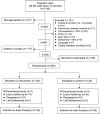Case Management may Reduce Emergency Department Frequent use in a Universal Health Coverage System: a Randomized Controlled Trial
- PMID: 27400922
- PMCID: PMC5400747
- DOI: 10.1007/s11606-016-3789-9
Case Management may Reduce Emergency Department Frequent use in a Universal Health Coverage System: a Randomized Controlled Trial
Abstract
Background: Frequent emergency department (ED) users account for a disproportionately high number of ED visits. Studies on case management (CM) interventions to reduce frequent ED use have shown mixed results, and few studies have been conducted within a universal health coverage system.
Objective: To determine whether a CM intervention-compared to standard emergency care-reduces ED attendance.
Design: Randomized controlled trial.
Participants: Two hundred fifty frequent ED users (5 or more visits in the prior 12 months) who visited a public urban ED at the Lausanne University Hospital between May 2012 and July 2013 were allocated to either an intervention (n = 125) or control (n = 125) group, and monitored for 12 months.
Interventions: An individualized CM intervention consisting of concrete assistance in obtaining income entitlements, referral to primary or specialty medical care, access to mental health care or substance abuse treatment, and counseling on at-risk behaviors and health care utilization (in addition to standard care) at baseline and 1, 3, and 5 months.
Main measures: We used a generalized linear model for count data (negative binomial distribution) to compare the number of ED visits during the 12-month follow-up between CM and usual care, from an intention-to-treat perspective.
Key results: At 12 months, there were 2.71 (±0.23) ED visits in the intervention group versus 3.35 (±0.32) visits among controls (ratio = 0.81, 95 % CI = 0.63; 1.02). In the multivariate model, the effect of the CM intervention on the number of ED visits approached statistical significance (b = -0.219, p = 0.075). The presence of poor social determinants of health was a significant predictor of ED use in the multivariate model (b = 0.280, p = 0.048).
Conclusions: CM may reduce ED use by frequent users through an improved orientation to the health care system. Poor social determinants of health significantly increase use of the ED by frequent users.
Keywords: case management; clinical trials; utilization; vulnerable populations.
Conflict of interest statement
The authors declare that they do not have a conflict of interest.
Comment in
-
Capsule Commentary on Bodenmann et al., Case Management May Reduce Emergency Department Frequent Use in a Universal Health Coverage System: a Randomized Controlled Trial.J Gen Intern Med. 2017 May;32(5):556. doi: 10.1007/s11606-016-3829-5. J Gen Intern Med. 2017. PMID: 27496145 Free PMC article. No abstract available.
References
-
- van Tiel S, Rood PP, Bertoli-Avella AM, et al. Systematic review of frequent users of emergency departments in non-US hospitals: state of the art. Eur J Emerg Med. 2015. - PubMed
Publication types
MeSH terms
LinkOut - more resources
Full Text Sources
Other Literature Sources
Medical


